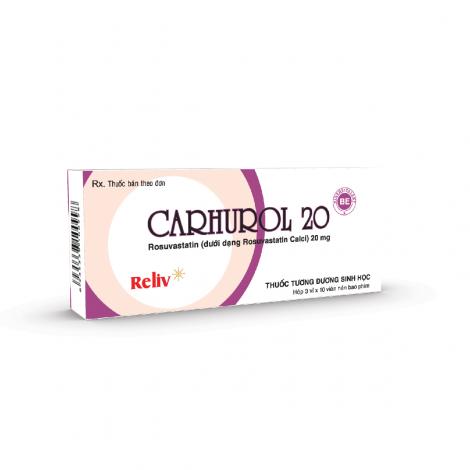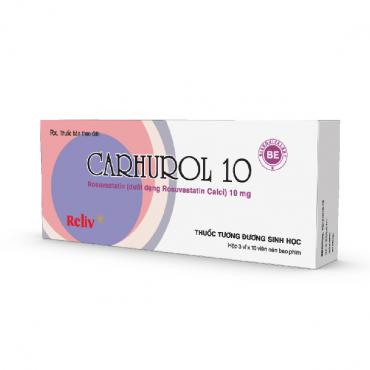Before treatment initiation the patient should be placed on a standard cholesterol-lowering diet that should continue during treatment. The dose should be individualised according to the goal of therapy and patient response, using current consensus guidelines.
Treatment of hypercholesterolaemia\The recommended start dose is 5 or 10 mg orally once daily in both statin naï ve or patients switched from another HMG CoA reductase inhibitor. The choice of start dose should take into account the individual patient's cholesterol level and future cardiovascular risk as well as the potential risk for adverse reactions (see below). A dose adjustment to the next dose level can be made after 4 weeks, if necessary. In light of the increased reporting rate of adverse reactions with the 40 mg dose compared to lower doses, a final titration to the maximum dose of 40 mg should only be considered in patients with severe hypercholesterolaemia at high cardiovascular risk (in particular those with familial hypercholesterolaemia), who do not achieve their treatment goal on 20 mg, and in whom routine follow-up will be performed. Specialist supervision is recommended when the 40 mg dose is initiated.
Prevention of cardiovascular events
In the cardiovascular events risk reduction study, the dose used was 20 mg daily.
Paediatric population
Paediatric use should only be carried out by specialists.
Children and adolescents 6 to 17 years of age (Tanner Stage
Heterozygous familial hypercholesterolaemia
In children and adolescents with heterozygous familial hypercholesterolaemia the usual start dose is 5mg daily.
• In children 6 to 9 years of age with heterozygous familial hypercholesterolaemia, the usual dose range is 5-10 mg orally once daily. Safety and efficacy of doses greater than 10 mg have not been studied in this population.
• In children 10 to 17 years of age with heterozygous familial hypercholesterolaemia, the usual dose range is 5-20 mg orally once daily. Safety and efficacy of doses greater than 20 mg have not been studied in this population.
Titration should be conducted according to the individual response and tolerability in paediatric patients, as recommended by the paediatric treatment recommendations. Children and adolescents should be placed on standard cholesterol-lowering diet before rosuvastatin treatment initiation; this diet should be continued during rosuvastatin treatment.
Homozygous familial hypercholesterolaemia
In children 6 to 17 years of age with homozygous familial hypercholesterolaemia, the recommended maximum dose is 20 mg once daily.
A starting dose of 5 to 10 mg once daily depending on age, weight and prior statin use is advised. Titration to the maximum dose of 20 mg once daily should be conducted according to the individual response and tolerability in paediatric patients, as recommended by the paediatric treatment recommendations. Children and adolescents should be placed on standard cholesterol-lowering diet before rosuvastatin treatment initiation; this diet should be continued during rosuvastatin treatment.
There is limited experience with doses other than 20 mg in this population.
The 40 mg tablet is not suitable for use in paediatric patients.
Children younger than 6 years
The safety and efficacy of use in children younger than 6 years has not been studied. Therefore, Rosuvastatin is not recommended for use in children younger than 6 years.
Use in the elderly
A start dose of 5 mg is recommended in patients > 70 years. No other dose adjustment is necessary in relation to age.
Dosage in patients with renal insufficiency
No dose adjustment is necessary in patients with mild to moderate renal impairment. The recommended start dose is 5 mg in patients with moderate renal impairment (creatinine clearance < 60 ml/min). The 40mg dose is contraindicated in patients with moderate renal impairment. The use of Rosuvastatin in patients with severe renal impairment is contraindicated for all doses.
Dosage in patients with hepatic impairment
There was no increase in systemic exposure to rosuvastatin in subjects with Child-Pugh scores of 7 or below. However, increased systemic exposure has been observed in subjects with Child-Pugh scores of 8 and 9. In these patients an assessment of renal function should be considered. There is no experience in subjects with Child-Pugh scores above 9. Rosuvastatin is contraindicated in patients with active liver disease.
Race
Increased systemic exposure has been seen in Asian subjects. The recommended start dose is 5 mg for patients of Asian ancestry. The 40 mg dose is contraindicated in these patients.
Genetic polymorphisms
Specific types of genetic polymorphisms are known that can lead to increased rosuvastatin exposure. For patients who are known to have such specific types of polymorphisms, a lower daily dose of Rosuvastatin is recommended.
Dosage in patients with pre-disposing factors to myopathy
The recommended start dose is 5 mg in patients with predisposing factors to myopathy.
The 40 mg dose is contraindicated in some of these patients.
Concomitant therapy
Rosuvastatin is a substrate of various transporter proteins (e.g. OATP1B1 and BCRP). The risk of myopathy (including rhabdomyolysis) is increased when Rosuvastatin is administered concomitantly with certain medicinal products that may increase the plasma concentration of rosuvastatin due to interactions with these transporter proteins (e.g. ciclosporin and certain protease inhibitors including combinations of ritonavir with atazanavir, lopinavir and/or tipranavir). Whenever possible, alternative medications should be considered, and, if necessary, consider temporarily discontinuing Rosuvastatin therapy. In situations where co-administration of these medicinal products with Rosuvastatin is unavoidable, the benefit and the risk of concurrent treatment and Rosuvastatin dosing adjustments should be carefully considered.
METHOD OF ADMINISTRATION
Rosuvastatin may be given at any time of day, with or without food.
In patients with hypersensitivity to rosuvastatin or to any of the excipients.
- In patients with active liver disease including unexplained, persistent elevations of serum transaminases and any serum transaminase elevation exceeding 3 times the upper limit of normal (ULN).
- In patients with severe renal impairment (creatinine clearance <30 ml/min).
- In patients with myopathy.
- In patients receiving concomitant combination of sofosbuvir/ velpatasvir/ voxilaprevir.
- In patients receiving concomitant ciclosporin.
- During pregnancy and lactation and in women of childbearing potential not using appropriate contraceptive measures.
The 40 mg dose is contraindicated in patients with pre-disposing factors for myopathy/rhabdomyolysis. Such factors include:
- Moderate renal impairment (creatinine clearance < 60 ml/min)
- Hypothyroidism
- Personal or family history of hereditary muscular disorders
- Previous history of muscular toxicity with another HMG-CoA reductase inhibitor or fibrate
- Alcohol abuse
- Situations where an increase in plasma levels may occur
- Asian patients
- Concomitant use of fibrates.
Renal Effects
Proteinuria, detected by dipstick testing and mostly tubular in origin, has been observed in patients treated with higher doses of Rosuvastatin, in particular 40 mg, where it was transient or intermittent in most cases. Proteinuria has not been shown to be predictive of acute or progressive renal disease. The reporting rate for serious renal events in post-marketing use is higher at the 40 mg dose. An assessment of renal function should be considered during routine follow-up of patients treated with a dose of 40 mg.
Skeletal Muscle Effects
Effects on skeletal muscle e.g. myalgia, myopathy and, rarely, rhabdomyolysis have been reported in Rosuvastatin-treated patients with all doses and in particular with doses > 20 mg. Very rare cases of rhabdomyolysis have been reported with the use of ezetimibe in combination with HMG-CoA reductase inhibitors. A pharmacodynamic interaction cannot be excluded and caution should be exercised with their combined use. As with other HMG-CoA reductase inhibitors, the reporting rate for rhabdomyolysis associated with Rosuvastatin in post-marketing use is higher at the 40 mg dose.
Creatine Kinase Measurement
If CK levels are significantly elevated at baseline (>5xULN) a confirmatory test should be carried out within 5 – 7 days. If the repeat test confirms a baseline CK >5xULN, treatment should not be started.
Before Treatment
Rosuvastatin, as with other HMG-CoA reductase inhibitors, should be prescribed with caution in patients with pre-disposing factors for myopathy/rhabdomyolysis. Such factors include: renal impairment, hypothyroidism, personal or family history of hereditary muscular disorders, previous history of muscular toxicity with another HMG-CoA reductase inhibitor or fibrate, alcohol abuse, age >70 years, situations where an increase in plasma levels may occur, concomitant use of fibrates.
In such patients the risk of treatment should be considered in relation to possible benefit and clinical monitoring is recommended. If CK levels are significantly elevated at baseline (> 5xULN) treatment should not be started.
Whilst on Treatment
Patients should be asked to report inexplicable muscle pain, weakness or cramps immediately, particularly if associated with malaise or fever. CK levels should be measured in these patients.
Creatine Kinase (CK) should not be measured following strenuous exercise or in the presence of a plausible alternative cause of CK increase which may confound interpretation of the result.
Liver Effects
As with other HMG-CoA reductase inhibitors, Rosuvastatin should be used with caution in patients who consume excessive quantities of alcohol and/or have a history of liver disease.
It is recommended that liver function tests be carried out prior to, and 3 months following, the initiation of treatment. Rosuvastatin should be discontinued or the dose reduced if the level of serum transaminases is greater than 3 times the upper limit of normal. The reporting rate for serious hepatic events (consisting mainly of increased hepatic transaminases) in post-marketing use is higher at the 40 mg dose.
In patients with secondary hypercholesterolaemia caused by hypothyroidism or nephrotic syndrome, the underlying disease should be treated prior to initiating therapy with Rosuvastatin.
Race
Pharmacokinetic studies show an increase in exposure in Asian subjects compared with Caucasians.
Protease Inhibitors
Increased systemic exposure to rosuvastatin has been observed in subjects receiving rosuvastatin concomitantly with various protease inhibitors in combination with ritonavir. Consideration should be given both to the benefit of lipid lowering by use of Rosuvastatin in HIV patients receiving protease inhibitors and the potential for increased rosuvastatin plasma concentrations when initiating and up titrating Rosuvastatin doses in patients treated with protease inhibitors. The concomitant use with certain protease inhibitors is not recommended unless the dose of Rosuvastatin is adjusted.
Interstitial Lung Disease
Exceptional cases of interstitial lung disease have been reported with some statins, especially with long-term therapy. Presenting features can include dyspnoea, non-productive cough and deterioration in general health (fatigue, weight loss and fever). If it is suspected a patient has developed interstitial lung disease, statin therapy should be discontinued.
Diabetes Mellitus
Some evidence suggests that statins as a class raise blood glucose and in some patients, at high risk of future diabetes, may produce a level of hyperglycaemia where formal diabetes care is appropriate. This risk, however, is outweighed by the reduction in vascular risk with statins and therefore should not be a reason for stopping statin treatment. Patients at risk (fasting glucose 5.6 to 6.9 mmol/l, BMI >30 kg/m2, raised triglycerides, hypertension) should be monitored both clinically and biochemically according to national guidelines.
In the JUPITER study, the reported overall frequency of diabetes mellitus was 2.8% in rosuvastatin and 2.3% in placebo, mostly in patients with fasting glucose 5.6 to 6.9 mmol/l.
Paediatric Population
The evaluation of linear growth (height), weight, BMI (body mass index), and secondary characteristics of sexual maturation by Tanner staging in paediatric patients 6 to 17 years of age taking rosuvastatin is limited to a two-year period. After two years of study treatment, no effect on growth, weight, BMI or sexual maturation was detected.
In a clinical trial of children and adolescents receiving rosuvastatin for 52 weeks, CK elevations >10xULN and muscle symptoms following exercise or increased physical activity were observed more frequently compared to observations in clinical trials in adults.
Lactose Intolerance
Patients with rare hereditary problems of galactose intolerance, the Lapp lactase deficiency or glucose-galactose malabsorption should not take this medicine
Erythrosine lake dye:
The medicine contains a small amount of erythrosin lake dye, it can cause allergic reactions or affect thyroid function.






